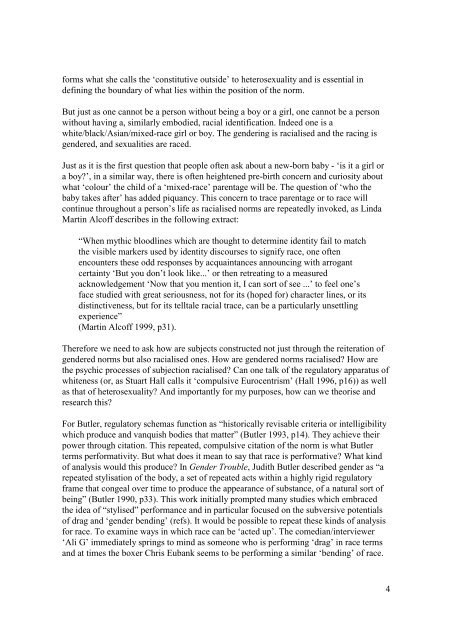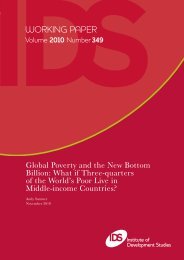1 'Troubling race. Using Judith Butler's work to think about racialised ...
1 'Troubling race. Using Judith Butler's work to think about racialised ...
1 'Troubling race. Using Judith Butler's work to think about racialised ...
Create successful ePaper yourself
Turn your PDF publications into a flip-book with our unique Google optimized e-Paper software.
forms what she calls the ‘constitutive outside’ <strong>to</strong> heterosexuality and is essential in<br />
defining the boundary of what lies within the position of the norm.<br />
But just as one cannot be a person without being a boy or a girl, one cannot be a person<br />
without having a, similarly embodied, racial identification. Indeed one is a<br />
white/black/Asian/mixed-<strong>race</strong> girl or boy. The gendering is <strong>racialised</strong> and the racing is<br />
gendered, and sexualities are <strong>race</strong>d.<br />
Just as it is the first question that people often ask <strong>about</strong> a new-born baby - ‘is it a girl or<br />
a boy?’, in a similar way, there is often heightened pre-birth concern and curiosity <strong>about</strong><br />
what ‘colour’ the child of a ‘mixed-<strong>race</strong>’ parentage will be. The question of ‘who the<br />
baby takes after’ has added piquancy. This concern <strong>to</strong> t<strong>race</strong> parentage or <strong>to</strong> <strong>race</strong> will<br />
continue throughout a person’s life as <strong>racialised</strong> norms are repeatedly invoked, as Linda<br />
Martin Alcoff describes in the following extract:<br />
“When mythic bloodlines which are thought <strong>to</strong> determine identity fail <strong>to</strong> match<br />
the visible markers used by identity discourses <strong>to</strong> signify <strong>race</strong>, one often<br />
encounters these odd responses by acquaintances announcing with arrogant<br />
certainty ‘But you don’t look like...’ or then retreating <strong>to</strong> a measured<br />
acknowledgement ‘Now that you mention it, I can sort of see ...’ <strong>to</strong> feel one’s<br />
face studied with great seriousness, not for its (hoped for) character lines, or its<br />
distinctiveness, but for its telltale racial t<strong>race</strong>, can be a particularly unsettling<br />
experience”<br />
(Martin Alcoff 1999, p31).<br />
Therefore we need <strong>to</strong> ask how are subjects constructed not just through the reiteration of<br />
gendered norms but also <strong>racialised</strong> ones. How are gendered norms <strong>racialised</strong>? How are<br />
the psychic processes of subjection <strong>racialised</strong>? Can one talk of the regula<strong>to</strong>ry apparatus of<br />
whiteness (or, as Stuart Hall calls it ‘compulsive Eurocentrism’ (Hall 1996, p16)) as well<br />
as that of heterosexuality? And importantly for my purposes, how can we theorise and<br />
research this?<br />
For Butler, regula<strong>to</strong>ry schemas function as “his<strong>to</strong>rically revisable criteria or intelligibility<br />
which produce and vanquish bodies that matter” (Butler 1993, p14). They achieve their<br />
power through citation. This repeated, compulsive citation of the norm is what Butler<br />
terms performativity. But what does it mean <strong>to</strong> say that <strong>race</strong> is performative? What kind<br />
of analysis would this produce? In Gender Trouble, <strong>Judith</strong> Butler described gender as “a<br />
repeated stylisation of the body, a set of repeated acts within a highly rigid regula<strong>to</strong>ry<br />
frame that congeal over time <strong>to</strong> produce the appearance of substance, of a natural sort of<br />
being” (Butler 1990, p33). This <strong>work</strong> initially prompted many studies which emb<strong>race</strong>d<br />
the idea of “stylised” performance and in particular focused on the subversive potentials<br />
of drag and ‘gender bending’ (refs). It would be possible <strong>to</strong> repeat these kinds of analysis<br />
for <strong>race</strong>. To examine ways in which <strong>race</strong> can be ‘acted up’. The comedian/interviewer<br />
‘Ali G’ immediately springs <strong>to</strong> mind as someone who is performing ‘drag’ in <strong>race</strong> terms<br />
and at times the boxer Chris Eubank seems <strong>to</strong> be performing a similar ‘bending’ of <strong>race</strong>.<br />
4

















